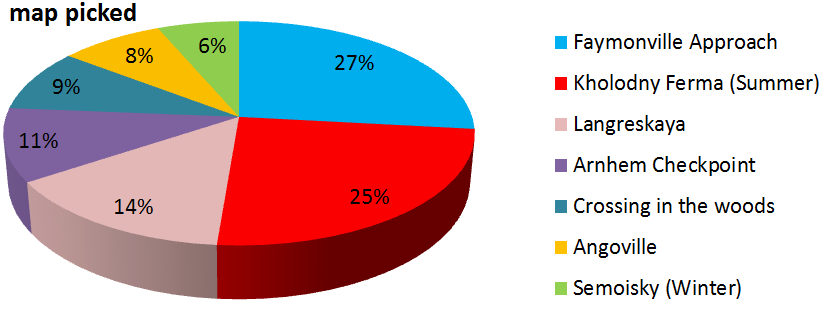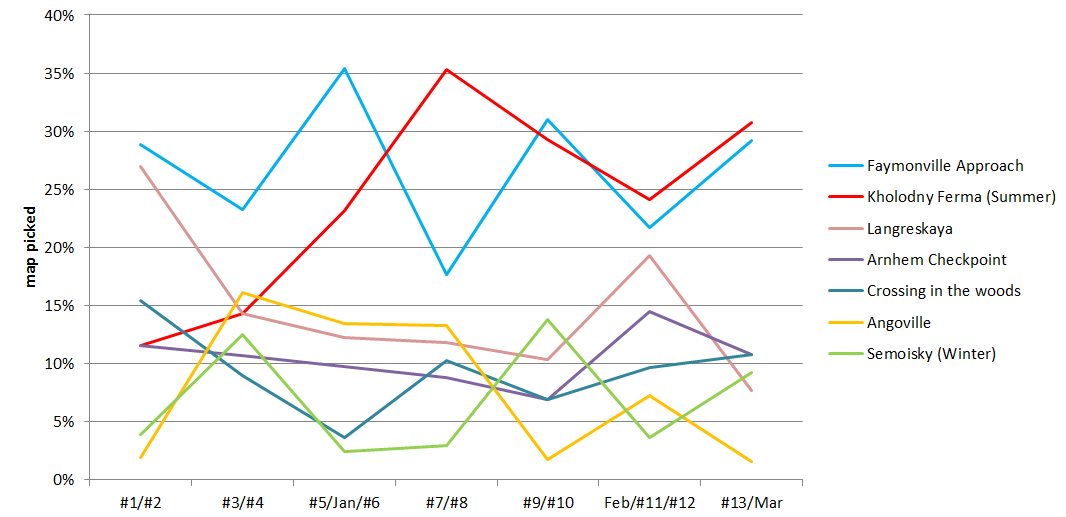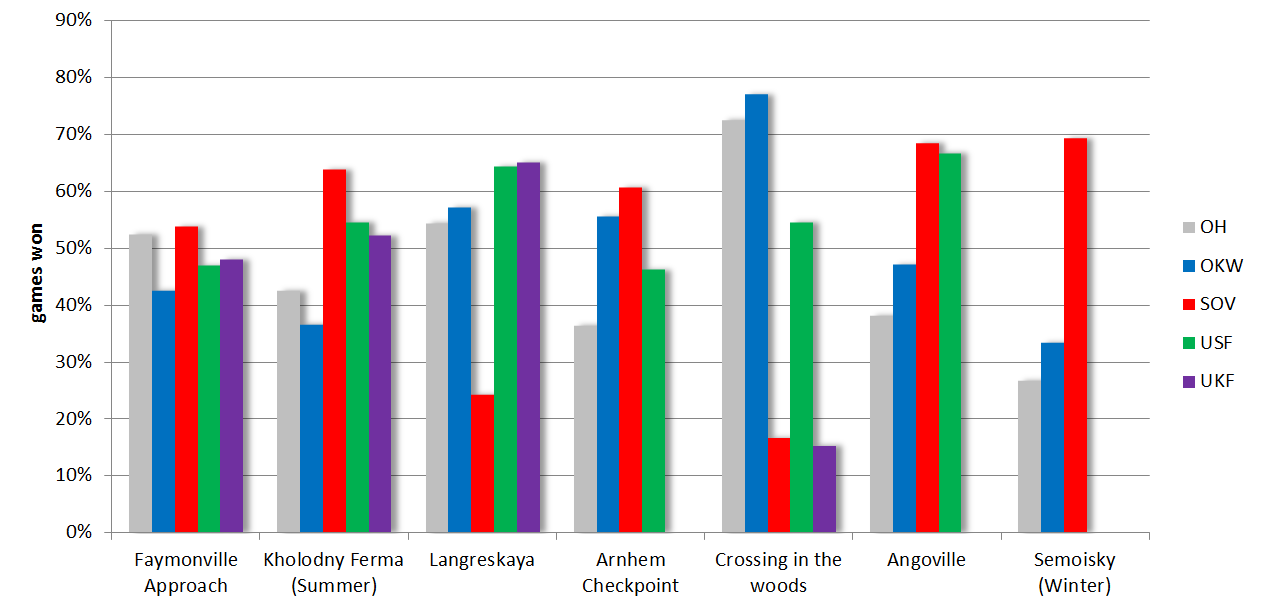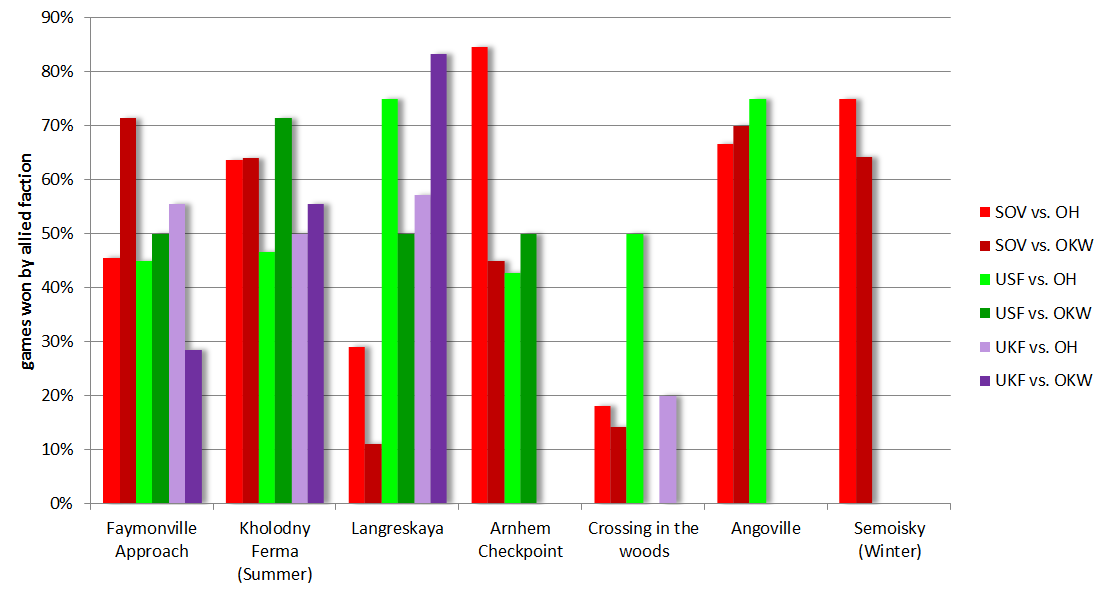Maps
The map pool for the tournaments contained seven maps:
- Faymonville Approach (FA)
- Kholodny Ferma (Summer) (KF)
- Langreskaya
- Arnhem Checkpoint (AC)
- Crossing in the woods
- Angoville
- Semoisky (Winter) (SEM)
The most popular map during the tournament was FA with KF as a close second. Both had more than 50% of the games between them:

Since all games used for this statistic were from the Best of Three rounds, map balance might not be the most important criterion for the players's choices - at least for the first two games. Map choices seem to have depended much on personal preference, as the significant differences between the picks of NA and EU players indicate:

The first cups had unusual rules to determine the map, where it was possible for one player to pick the map to counter the faction choice of the other player. This was quickly fixed for the following cups reverting to a standard veto system, but this is likely the reason why the map picks changed significantly after the first cups:

Maps vs. Factions
The following diagram shows how many games each faction won on each map. For certain combinations - in particular for USF and UKF - the sample sizes are too small to compute reliable percentages. Therefore, results with fewer than 10 samples (AC/UKF, Angoville/UKF, SEM/USF, SEM/UKF) have been omitted in the diagram:

FA overall appears to be the most balanced map which might be the reason why it is also the most played one. All others show quite significant differences between factions.
The two Axis factions behave relatively similarly, with the exception of AC, where OKW has a significantly higher win ratio than OH. The Allied factions, on the other hand, vary strongly depending on the map. While USF and UKF have a high win ratio on Langreskaya, Soviets do poorly there. USF is rather successful on Crossing, where both other Allied factions exhibit their worst win ratios. Angoville is dominated by Soviets and USF.
While Soviets appear to be the strongest faction on multiple maps, they also yield very poor win percentages on Langreskaya and Crossing. This is likely the reason for the low Soviet win ratio in the first round of cups where it was possible to pick a map countering the opponent's faction choice. Likewise, it might explain why USF - which does not exhibit similar weaknesses - was picked relatively often in the early tournaments.
Maps vs. Matchups
Finally, a look at certain matchups on the different maps.
Number of games per matchup and map:
 vs vs |  vs vs |  vs vs |  vs vs |  vs vs |  vs vs | |
| Faymonville Approach | 46 | 21 | 20 | 12 | 18 | 7 |
| Kholodny Ferma (Summer) | 44 | 25 | 15 | 7 | 14 | 9 |
| Langreskaya | 24 | 9 | 8 | 6 | 14 | 6 |
| Arnhem Checkpoint | 13 | 20 | 7 | 6 | 2 | 1 |
| Crossing in the woods | 11 | 7 | 8 | 3 | 10 | 3 |
| Angoville | 9 | 10 | 8 | 4 | 4 | 3 |
| Semoisky (Winter) | 12 | 14 | 1 | 1 | 2 | 0 |
Games won by Allied faction per matchup and map:
 vs vs |  vs vs |  vs vs |  vs vs |  vs vs |  vs vs | |
| Faymonville Approach | 21 | 15 | 9 | 6 | 10 | 2 |
| Kholodny Ferma (Summer) | 28 | 16 | 7 | 5 | 7 | 5 |
| Langreskaya | 7 | 1 | 6 | 3 | 8 | 5 |
| Arnhem Checkpoint | 11 | 9 | 3 | 3 | 0 | 0 |
| Crossing in the woods | 2 | 1 | 4 | 2 | 2 | 0 |
| Angoville | 6 | 7 | 6 | 2 | 1 | 0 |
| Semoisky (Winter) | 9 | 9 | 1 | 1 | 1 | 0 |
or in percentages:

Bars have been omitted when the sample size is five or less. It has to be noted that sample sizes for most matchup/map combinations are comparably small, so the resulting win percentages are not overly reliable.
Still, they indicate more pronounced difference between the two Axis factions on some maps. For example, while OKW is doing well against UKF on FA, they perform poorly vs the Soviets. The win percentage for Soviets on Langreskaya is much lower against OKW compared with OH. On the other hand, Soviets won almost all games against OH on AC, while the win percentage vs. OKW is below 50%.











 cblanco ★
cblanco ★  보드카 중대
보드카 중대  VonManteuffel
VonManteuffel  Heartless Jäger
Heartless Jäger 